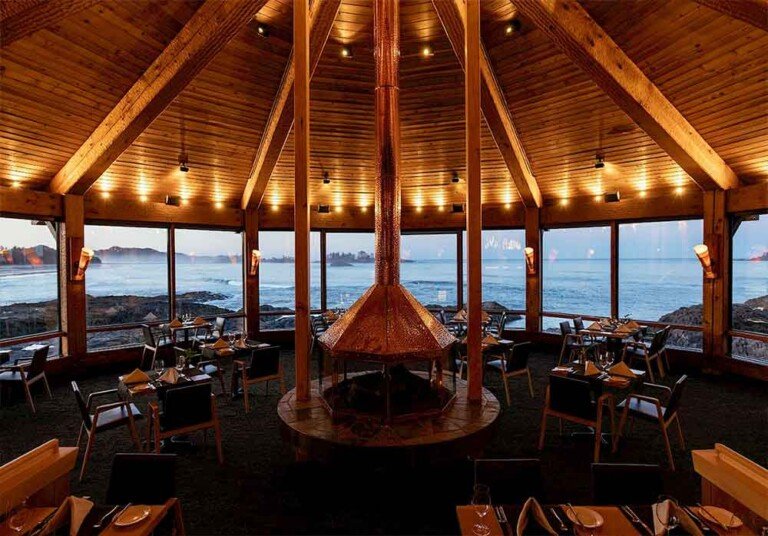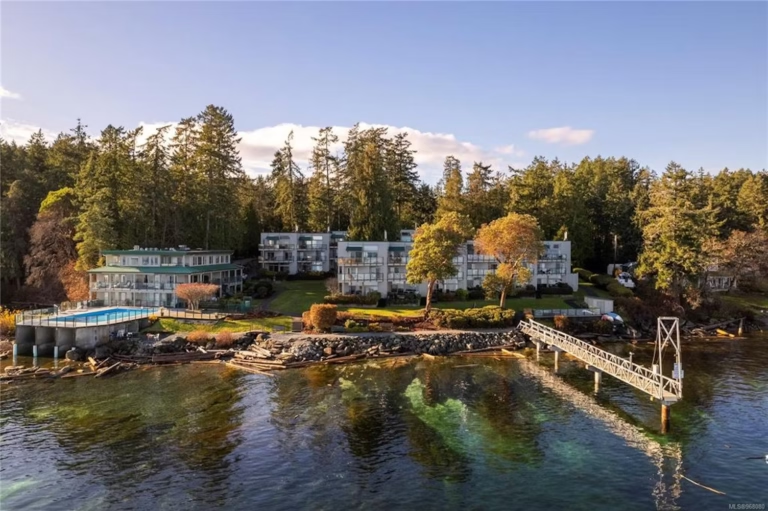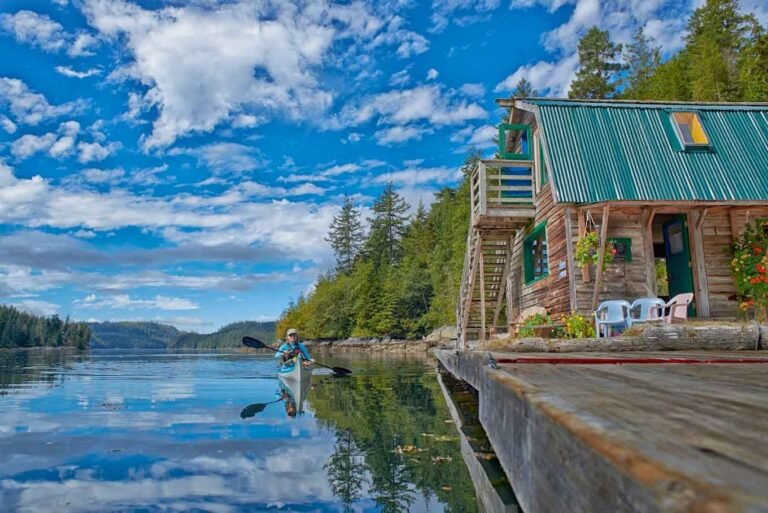Premier Listings for Barkley Sound
Barkley Sound and the Broken Group Islands comprise one of the three main recreational components in Pacific Rim National Park. The popularity of these islands with paddlers and boaters has soared over the past decade, much to the dismay of longtime observers.
Barkley Sound lies south of Ucluelet and north of Bamfield on the west coast of Vancouver Island, covering an area of approximately 800 square kilometres that includes hundreds of islands, none of which is larger than 2 kilometres across.
The sound was explored and named in 1787 by Captain Charles William Barkley of the Imperial Eagle, a British Trading vessel sailing under Austrian colours. Barkley was accompanied by his 17-year-old bride, Frances, the first white woman to see British Columbia.
The ease with which less-experienced sea kayakers can reach the Broken Group Islands on the MV Frances Barkley from Port Alberni and Ucluelet contributes greatly to their allure and charm. The best paddling is from April to October, and if you must visit during the peak season in July and August, be sure to reserve space for your kayak or canoe on deck well in advance. Consider adventuring here in any month other than July and August, particularly if you value solitude.
The MV Frances Barkley is based in Port Alberni, with routes that lead through the Broken Group Islands in Barkley Sound to the fishing ports of Bamfield and Ucluelet. In the course of a day’s trip the sturdy wooden packet freighter drops mail, groceries, supplies, and the occasional passenger along the way at float homes and the Sechart Whaling Station. The trip makes a pleasant outing in itself or can be a link for paddlers to the Broken Group Islands. MV Frances Barkley transport service.
At times you’ll definitely feel the motion of the ocean swells, but the better part of the journey through Barkley Sound is not as exposed as that experienced when you travel on the MV Uchuck III to Nootka Sound from Gold River.
Kayakers usually begin their exploration at Gibraltar Island and make their way through the chain, stopping at campsites on Gilbert, Clarke, Turret, Willis, and Hand Islands. All of these sites are easily reached within a day’s paddle (or less) of each other. Camping is also allowed on Gibraltar Island and Dodd Island. Numerous kayak operators lead tours through the Broken Group Islands.
Camping was discontinued on Benson Island in May 2009 out of respect for its cultural significance. Archaeological research dates traditional use of Benson Island for over 5,000 years. Tseshaht First Nation’s oral traditions name this site as their origin place where the first Tseshaht man (Naasiya’atu) and woman (Naasayilhim) were created. It became the site of their principal village of Ts’ishaa. It is from this village that the Tseshaht derive their name, as Tseshaht literally means “people of Ts’ishaa”. Visitors are encouraged to visit Benson Island during the day and return to designated campsites for the night.
The west coast of Vancouver Island is exposed to the moisture-laden westerly winds blowing off the warmer Pacific Ocean. The warm air masses are forced up by the island’s mountain ranges, resulting in considerable precipitation falling on the Pacific Rim region during the winter months of September to March, while summers are relatively dry. The abundant rainfall and mild temperatures account for the lush vegetation and the wonderful rainforests found in the region. Old-growth forests include species such as the sitka spruce, western hemlock and western red cedar, and the undergrowth is thick with salal and evergreen huckleberry, both of which are harvested for the florist industry.
Barkley Sound falls within the traditional territory of the Nuu-chah-nulth people who have occupied most of the west coast of Vancouver Island for some four thousand years, living a semi-nomadic existence. They lived part of the year in the protected islands and bays of the sound, and the remainder of the year on the outer islands and exposed shores of the Pacific Ocean. Native archeological sites attest to their occupation of the land before the arrival of Europeans, with stonewall fish traps, shell middens and terraced village sites remaining to be admired today. Visitors should not disturb any of these archeological sites, and it is illegal to dig in a midden without the requisite permit.
Location: Barkley Sound is located south of Ucluelet and north of Bamfield on the west coast of Vancouver Island. The sound is either accessed from these two communities or from Port Alberni by travelling down Alberni Inlet. The route of the MV Frances Barkley, based in Port Alberni, leads through the Broken Group Islands in Barkley Sound to the fishing ports of Bamfield and Ucluelet. In the course of a day’s trip the sturdy wooden packet freighter drops mail, groceries, supplies, and the occasional passenger along the way at float homes and the Sechart Whaling Station.
Sea Kayaking: Kayakers can reach the sound by road by turning south off Highway 4 at Kennedy Lake onto the marked gravel logging road, halfway down the lake, that leads down to Toquart Bay. Drinking water should be carried, as it is not available in the Broken Group Islands. It can rain at any time on the west coast, making rain gear an essential item, and sea fog rolling in off the Pacific is a common occurrence, sometimes persisting for several days.
Fog can occur at any time between June and October, with the highest occurrence during August. The prevailing westerly winds are very predictable in the summer months; calm in the morning, strengthening during the day and peaking in the afternoon before dropping again before dusk. Exposed waters should therefore be paddled during the mornings, and protected waters navigated in the afternoons.
Sea Kayaking around Vancouver Island.
Diving in Barkley Sound is excellent, thanks to the rich and diverse marine life, numerous reefs and up to 60 old shipwrecks in the area. This area has been called the Graveyard of the Pacific because many navigators from days past would mistake Barkley Sound for the Juan de Fuca Strait, ending up on the many reefs and islands that dot the sound. In 1972 the Vanlene sank off the east side of Austin Island with a cargo of 300 Japanese cars.
Camping: There are 7 designated campsites in the Broken Group Islands, most of which are relatively small. Wardens patrolling in inflatables confine camping to these areas only, in order to lessen the impact on the park environment. Hand Island is very popular, as most paddlers entering the Broken Group land there first. Likewise, Gibraltar Island is busier as it is closest to the drop-off point of the MV Frances Barkley. Although the campsites are busy during the peak season, the great sense of comradeship amongst the paddlers creates a great atmosphere in the campgrounds. Facilities are limited, and firewood, picnic tables, cooking facilities and garbage disposal are not provided. Firewood is scarce and usually non-existent near designated camping areas, so stoves should be carried.
Toquart Bay Recreation Site offers a campground with over 80 campsites and parking for fishermen and kayakers. Next to the campground is a marina with boat moorage and a boat launch. The nearby Toquart Bay Store operated by the Toquaht Nation serves visitors to the area and residents of Macoah and Salmon Beach Recreational Village. Access to the campground is off Highway 4 at Kennedy Lake, via Maggie Lake and Toquart Bay FSR gravel roads (16 kms).
Most of the Deer Group Islands are crown land, and being outside of the Pacific Rim National Park, they are available for camping. However, suitable camping locations and clearings are restricted by the dense forest and high tides that extend to the edge of the forest, with no beach above the high tide mark. There is good camping on Diana Island, near the northeast corner and the southern tip, on Stud Islets, and on the small islands south of Fleming Island. Avoid camping on Indian Reserve lands without their permission. The easiest access to the Deer Group is from Port Desire at the head of Grappler Inlet, adjacent to the town of Bamfield. The Deer Group chain of 6 main islands is only about 20 kilometres long, but it will take at least 3 days to paddle around them.
No-Trace Camping: Visitors here should please take note that paddlers are increasingly being blamed for the trashiness around many of the more popular campsites. Except at the seven designated camping sites, garbage and toilet facilities are nonexistent, which should be a major consideration for visitors. Plan how you’re going to deal with these factors in advance of your journey here so as not to further tarnish an already delicate situation. Practice random acts of kindness by removing litter where you find it as well as packing out all of your own refuse. Consult books such as How to Shit in the Woods by Kathleen Meyer to learn new approaches to the delicate subject of backcountry hygiene.
Fishing: Bamfield, Ucluelet and Toquart Bay are used as base camps for sport fishermen fishing the productive waters of Barkley Sound and Alberni Inlet in search of chinook and coho salmon. Alberni Inlet and Barkley Sound offer fishing all year round. Salmon school in Alberni Inlet before ascending to their spawning grounds in the rivers and streams of Vancouver Island.
Hiking: The Wild Pacific Trail in Ucluelet skirts the rugged cliffs and shoreline of the westcoast of Vancouver Island. Overlooking Barkley Sound and the Broken Group Islands to the east and the open Pacific Ocean to the south and west, it offers spectacular shoreline panoramas and seaward vistas through ancient cedar and spruce-framed viewing platforms constructed on the best headlands along the route. The first segment of the trail is a 30-45 minute loop off Peninsula Road, using the adjoining He-Tin-Kis Park boardwalk, and passing Amphitrite Point Lighthouse. The trailhead for the main part of the trail is at Terrace Beach, with the trail hugging the coastline all the way to Halfmoon Bay in Pacific Rim National Park.
Wildlife: Shore dwelling wildlife in Barkley Sound includes mink, martens, river otters and raccoons, and marine life includes killer whales and grey whales, porpoises, basking sharks, harbour seals, California and Steller’s sea lions and six-gill sharks in the shallower depths between July and September. Columbian black-tail deer inhabit the forest and hundreds of seabird species nest in the sound. The birdlife increases dramatically during spring and fall, as migrating flocks descend on the sound en route to their distant feeding and breeding grounds. Barkley Sound is endowed with one of the highest concentrations of bald eagles in North America, with large, sturdy nests built aloft towering evergreen trees.
Marine Life in the sound is among the richest and most diverse found anywhere. Several factors account for this, including the nutrient-rich bottom water and the warming effect generated by the prevailing westerly winds. This north Pacific Coast boasts over ninety species of colourful starfish and forty species of shrimp. Check out the tidal pools on Benson Island.
Sea Caves: Explore the large sea caves on the southwest side of Dempster Island, and others on Dicebox Island, Gibraltar Island and at Meares Bluff on Effingham Island. Paddlers must be aware that pelagic cormorants frequently nest inside caves, and intrusions will alarm the cormorants and interfere with their breeding. Paddlers are asked to stay away from sea caves during the June to August breeding season.
Ancient Village: Of interest is the abandoned Indian village site at the beautiful beach on the northeast side of Effingham Island. The remains of several longhouses can still be seen.
Bamfield: The quaint little fishing village of Bamfield, lying on either side of Bamfield Inlet on the southern shore of Barkley Sound, is well known for its boardwalk along the harbour, with small art galleries and shops, where you can sit and relax and watch the steady stream of boats sliding by the shops and houses that overlook the inlet. Best known for its superb salmon fishing adventures, this harbour village is also an enchanting place to begin kayaking, canoeing or scuba diving.
Ucluelet: On the northwest shore of Barkley Sound is the ancient settlement of Ucluelet, which takes its name from the Nuu-chah-nulth phrase, Yu-clutl-ahts, the people with a good landing place for canoes. Now a logging, fishing and tourist village at the south end of Pacific Rim National Park, Ucluelet is a base for commercial and sport fishing, as well as kayaking and wildlife and whale watching excursions.
Premier Business Listings in Barkley Sound – West Coast Vancouver Island City Guide

Biographical Info
Enjoy a private beachfront cabin nestled in the clutches of a Pacific Rim rainforest, on the edge of the Wild Pacific Trail, where rugged shoreline meets the ferocious Pacific Ocean. Nature is everywhere, from huge expanses of sandy beaches, to intricate marine life in tidepools and giant cedars, hemlocks, and spruces. Located in Ucluelet at Terrace Beach, The Cabins is pet friendly.

Biographical Info
Mills Landing in Bamfield provides guests first class access to one of BC’s most beautiful, and productive fishing locations at an affordable price. Waterfront cedar cottages, premium fish processing, Grady Whites, Islander reels and the best in customer service keep our guests returning annually. Check us out once, chances are you’ll be back again!

Biographical Info
Mills Landing is a private oceanfront cottage resort located on the edge of Barkley Sound. Our cedar cottages are fully self-contained and very comfortable. Mills Landing offers accommodation, moorage, fishing charters, whale watching, nature adventures, and marine tours of the Broken Group Islands near Bamfield. Perfect for anglers wanting access to the best fishing on Vancouver Island, and for those looking to get away from it all.

Biographical Info
The Whale’s Tail Guest Suites are beautifully maintained, modern, private, clean, quiet and roomy travel apartments located in the ocean-front fishing village of Ucluelet. Full condo-style units with complete kitchens are provided with your choice of one, two and three-bedroom suites. The front desk is located one block north at the West Coast Motel on the Harbour, 279 Hemlock Street.

Biographical Info
Located in the quaint fishing village of Ucluelet, close to Barkley Sound, the Broken Group Islands, and the Pacific Rim National Park Reserve, our kayaking and hiking tours range from short half-day tours to week-long adventures. Whether you are an experienced or novice sea kayaker and/or hiker looking for a new and exciting adventure, or someone who is not really sure what the west coast of Vancouver Island is all about, we promise we will find the right experience for you.
Hello Nature Adventure Tours Video
Kayaking and hiking are great ways to explore the beautiful beaches, peaceful coves, offshore islands, wildlife and the native forests that make up our coastline. Participate at your own pace by sampling a half-day trip, full-day trip, or come on a guided overnight trip and allow us to take you to all of our favorite places.

Biographical Info
Cameron Ocean Adventures operates off the pristine Canadian shores of beautiful Ucluelet, home to Vancouver Island’s #1 trail, the Wild Pacific Trail. Cameron Ocean Adventures offers adventures in the waters of the Broken Group Islands and Barkley Sound in Pacific Rim National Park.
Experience first-class sport fishing for salmon and halibut, whale watching on the largest vessel in Ucluelet, and year-round custom charters with professional guides aboard clean, safe, luxury motor yachts that depart right from the convenient Ucluelet Harbour.
Join us for an experience you won’t forget.

Biographical Info
Pachena Bay Campground is nestled in an old-growth rainforest next to an expansive, sandy beach that directly faces the open Pacific Ocean. The campground is at the mouth of the Pachena River, next to the Huu-ay-aht First Nations community of Anacla, and just 5 kilometres from the picturesque town of Bamfield.
Enjoy unparalleled wilderness adventures, go beachcombing on pristine shores, hike through old-growth rainforests, and watch soaring eagles and other local wildlife along the way. Enjoy some of the world’s best sportfishing, kayaking, diving or eco- and cultural tourism adventures. The campground has been smartly upgraded to welcome RVs and campers, as well as tenting.

Biographical Info
Jason Priestley and family invite you to visit our secluded beachfront cabins in Ucluelet, nestled between the two main sections of Pacific Rim National Park – the Broken Group Islands to the south and Long Beach and Tofino to the north. Pet friendly Terrace Beach Resort connects to The Wild Pacific Trail. Outdoor hot tubs on the decks of several units.

Biographical Info
The charming and cozy Reef Point Cottages are located in Ucluelet on the west coast of Vancouver Island offering an exciting, intimate and self-indulging experience for those who want to explore British Columbia’s most spectacular and natural landscape. Our accommodations include view and waterfront cottages with various sizes from studio to two bedrooms.





